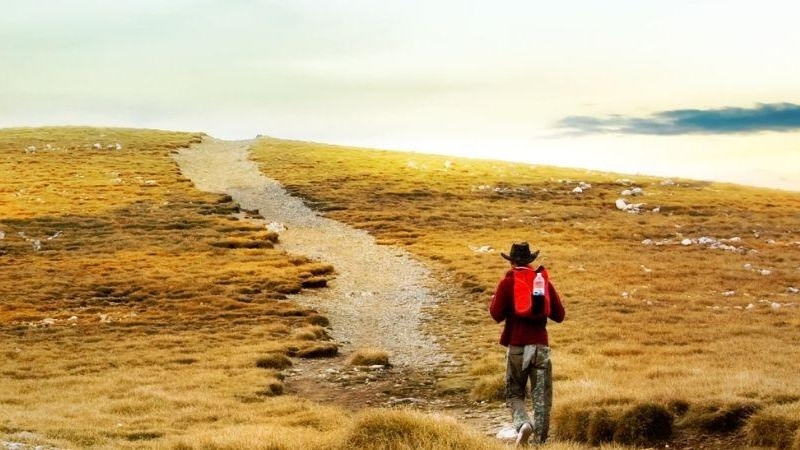On a quest to learn more about the rare and elusive beasts of Mindoro
Dusk came in hushed tones and opalescent hues, falling like a veil over the landscape. From the highest point of Mt. Magawang – a grassy ridge where wind waltzed with fog – the unbelievable terrain unfolded: hills dipped into valleys, soaring into peaks whose serrated and stratified edges ran in a grand and boundless loop. At day, these jagged forms seemed menacing; in this ebbing light, they looked like a dream.
Getting to this otherworld had not been easy. Two days on foot it took, but the blisters and scratches and promise of more pain slid off my mind at the sight of all this. And yet this view had not been the main reason why I came here. I’d shrugged off leeches and braved steep trails not for this glimpse of paradise but for a chance to encounter one of its dwellers.
I came here for the Tamaraw.
Home of hooves
Mt. Magawang, this spot where I stood, is part of the greater Mts. Iglit-Baco National Park (MIBNP). Covering a total of 75,445 hectares, this protected area in the island of Mindoro plays host to the largest remaining population of the Bubalus mindorensis.
Also known as the Mindoro dwarf buffalo, the tamaraw is the only bovine endemic to the Philippines. It is also the second largest native land mammal in the country, next only to the carabao. Its appearance is very similar to the latter, save for its horns which are V-shaped instead of curved. In further contrast with the carabao, the tamaraw is also notorious for being reclusive.
Used to number in the thousands, an epidemic of rinderpest in the 1930s coupled with poaching, hunting, and habitat loss had driven the tamaraw’s population to a mere few hundreds, making it critically endangered.

To address the need to protect these creatures, the Tamaraw Conservation Program (TCP) was birthed in 1979 by virtue of Executive Order No. 544. The TCP led to the establishment of a tamaraw gene pool which was tasked to revive the dwindling population. The breeding project had been unsuccessful, producing only one tamaraw in 1999. Kalikasang Bagong Sibol – Kali for short – remains, to this day, as the only tamaraw in captivity.
Guarding the beasts
At present, the TCP’s focus is on ensuring that the 523 tamaraws residing in MIBNP continue to thrive in the wild. Rangers and wardens risk their lives patrolling the mountainous regions of the park, often with meager means to protect themselves.
“We have been shot at many times,” shared Eudardo Bata, a senior Tamaraw Ranger.
Even TCP’s tools for recordkeeping and data-gathering are lacking. Not a single spotting scope. Not even one GPS device. There’s only a handful of binoculars, a weathered point-and-shoot, and an old, unserviceable desktop. In spite of this, the rangers push on with their duty – after all, dedication trumps dearth.

Crouch like this and watch
That day in mid-October, we’d hiked up Mt. Magawang in the hopes of spotting a Tamaraw. The ridge was supposed to be the ideal viewing deck, overlooking what was dubbed the “Tamaraw Plaza” – the creatures’ favorite grazing ground.
Many times, the rangers proved they needed no tools to do their job. With nothing but their naked eyes and profound knowledge of the land, they could easily tell beast from boulder. They could discern, without trouble at all, the tiniest and slightest of movements in this terrain they’ve memorized by heart.

There was only a couple of beasts we saw that day, owing perhaps to the fact that we were such a large group – the commotion, however controlled, was simply too much for the highly sensitive tamaraws.
The next morning, I was one of four who went back up Mt. Magawang to hopefully see more.
Dawn mimicked the colors of dusk: gentle pinks and soft oranges. Under the early light, we moved silently, closer to the Plaza. The rangers instructed us to sit low as they fanned out, surveying the landscape.
After what seemed like forever, five juvenile tamaraws emerged from a coppice of trees, cantering up a hill. Indeed, they look like the carabao, but oh how different they moved: galloping with impressive speed like a drove of mountain goats! When they reached the even ground, they paused and stared, as if curious. From afar, I could sense their eyes on us. It felt like we were being measured, whether we were a threat or not. As quickly as they came, they bounded off towards a thicket where they eventually disappeared.
Wild mementos
I still had my camera up, exhilarated by the encounter, when our guides shepherded us towards the outskirts of Mt. Magawang. It was a different path from the one we came and we were told there was a good chance we’d happen upon more tamaraws.
So we proceeded quietly, as stealthily as permitted by the rock-strewn trail, and halfway through, we spotted a trio of the beasts. A cow and a couple of yearlings. They huddled under a flourishing tree, the female eyeing us suspiciously. Moments later, like the group of juveniles earlier, they galloped to a grove, leaving us wide-eyed and full of wonder.

I felt my heart beating in my throat, and a heady sense of delight filled me. To witness these magnificent creatures in their beautiful natural habitat was simply surreal. And the thought that I might’ve had it all in photo was nothing short of euphoric.
This made the arduous journey more than fair. This made it worth it.
The Tamaraw Conservation Program is in dire need of binoculars, spotting scope, GPS devices, hiking gear, and uniforms for its rangers and wardens. To know more about and help save the Tamaraw, get in touch with the TCP through UNDP-BIOFIN c/o Angelique Ogena at angelique.ogena@undp.org.
by CELINE MURILLO
The Bull in the Bluff
Published on December 6, 2018
This post was last updated on March 26th, 2020 at 02:43 pm








